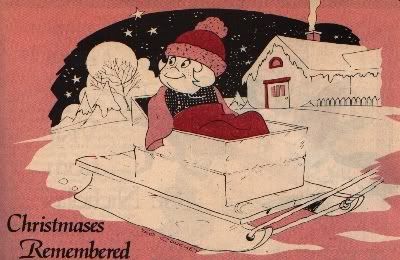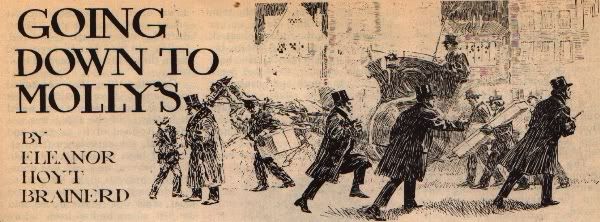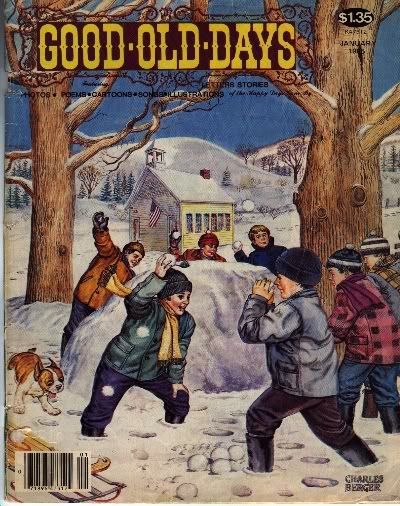I’ve written before about how it was during the 1983-85 period that I first became quite interested in old non-superhero comics (including those published by Charlton), classic comics artists like Ditko, Alex Toth, and Kurt Schaffenberger, old-time radio shows (including “The Hall of Fantasy”), pulp prose writing (old writers like H. P. Lovecraft as well as then-new equivalents like “Nick Carter, Killmaster” novels and “Ellery Queen’s Mystery Magazine”), silent movies, and so on -- interests which I would delve into further in the subsequent years but which first grabbed my attention when I became a teenager.
One of the things which caught my interest during that same period was “Good Old Days” magazine. In 1984, I was discovering the short stories of O. Henry and wishing that there was a publication around today that contained material told in an old-fashioned style, which I found to be more appealing and elegant than the modern plain style of telling tales. I liked it when an old story would use antiquated spelling, like “to-day” instead of “today,” and I began trying to emulate that in my own writing. If the “Nick Carter” novels and EQMM were a modern equivalent of the old pulps, then where was the modern equivalent of the popular magazines of the past like “Liberty” and “Saturday Evening Post,” which often featured quaint paintings of scenes from an idealized America on their covers?
As it happens, the “Saturday Evening Post” was still being published in 1984, and so I bought an issue of the magazine in the hope that it would feel like I was reading a magazine from the 1930s. Alas, this was not to be. The covers of the Post by now consisted of a photo of a current celebrity, and the issue struck me as dull and not evocative of the olden days. (Incidentally, “Reader’s Digest” would probably be the best modern equivalent in 2002 of those old magazines, albeit lacking the paintings on the covers. It’s still much less interesting than the old mags, though.)
At the end of 1984, I think I was in a Farmer Jack grocery store when I first saw (and bought) a copy of “Good Old Days” magazine. The issue was the 1984 Christmas Annual. The cover price was $1.50, and a blurb at the top said, “72 pages in this issue,” a line reminiscent perhaps of the old comicbooks, like Superman #1 which had “64 pages of action” on its cover. Like that Superman cover, the scene on the cover of this Good Old Days Christmas Annual was contained inside a circle. It was a painting showing an old man giving a boy a star-shaped cookie from a basket. The boy is holding a snowball behind his back, which suggests that he had intended originally to throw a snowball at the old man, until his mind was changed by the old man’s kindness to him. The houses in the background are reminiscent of the quaint houses of a European village, the kind that Ditko tends to draw. This was the kind of cover I’d been looking for!
Each issue of “Good Old Days” consists of short articles written by readers, remembering how life was like in the past, or relating interesting stories from their life years ago, supplemented by photos and drawings. This issue, of course, was devoted to tales of Christmas. Back then, “Good Old Days” had three regular cartoonists who contributed several spot illustrations each issue: Sid Couchey (who was interviewed recently in “Comic Book Artist” magazine for his Harvey Comics work), an artist who signed his name “Kauf,” and another who signed his name “SBest.” The illustration below is by Sid Couchey, taken from the 1984 Christmas Annual. At the time, I noticed the resemblance between Couchey’s art style and Harvey Comics art (the girl in the drawing below resembles Little Lotta), but wasn’t sure of the connection because I hadn’t heard anyone ever mention Sid Couchey being a comicbook artist anywhere (until I read “Comic Book Artist” in August 2002!). Twelve Couchey drawings appear in the Christmas Annual.

The issue contained an O. Henry-style fiction story titled “Going Down to Molly’s” by Eleanor Hoyt Brainerd. I have no idea where this story came from, when it was written, etc. Perhaps I’ll look it up on the internet and find out. But back when I bought the mag, it was harder to find out such things. All I knew is that it was an old-fashioned story taking place in New York at Christmas-time, with a young man riding in a bus who decides to join some fellow male passengers to a trip “down to Molly’s,” who there meets “the sweetest girl in the world [who] had taken him on faith and had called him her friend.”

The final few paragraphs contain the words “good-by” (twice), “to-morrow,” and “to-day.” Do I have to mention that I loved it? Not so much for the tale, nay, but how it was told -- the atmosphere perfectly evoked those old O. Henry type tales, the ones I wanted to read, the ones I wanted to write myself. They re-created the past for me, and let me pretend for a little while that I was living there.
So, I began picking up “Good Old Days” magazine sporadically, beginning with the January 1985 issue. The cover of that issue can be seen below. Is that a great cover or what? I seem to recall that it was snowy out when I bought that issue, and the cover helped me connect my current snowy present with the snowy days of the past.

Looking back on these issues of "Good Old Days," I'm struck by how prevalent the topic of religion is, perhaps because the readership of the magazine is most likely senior citizens, who are more likely to be church-going or perhaps reflecting an era when religious life was not considered something to be kept private as it often is portrayed today. Even the first page of the official "Good Old Days" website has a writer reminiscing about churches of his youth.
An article in the December 1990 issue, titled "Pulps in the Pulpit," was about a young pulp reader in the 1930s who had loaned some of his magazines to another kid. The other kid wouldn't return the books, and when the pulp fan brought the matter to the attention of the kid's mother, she called the mags "filthy" and said they should be thrown away. She wondered what the pastor would think of him "reading that kind of filth." So, the pulp fan brought the matter to his pastor, showing him some pulps and asking him to resolve the dispute. At church that Sunday,the pastor declared that the pulps were good, moral reading material and that they should be returned to the boy.
No overview of "Good Old Days" magazine would be complete without mentioning Harry Wilkinson, who wrote the column "Looking Hollywood Way" for the magazine from the 1960s until the 1990s. His column was my first exposure to written film history (as opposed to, say, seeing episodes of "That's Hollywood" on TV), in particular silent movies. Each column contained several photos of these stars, many of them long-forgotten today except by the most avid film buffs.
On Page 2 of this article, I'll be talking about old comic strips in "Good Old Days." And on Page 3, you can see some more examples of Sid Couchey's "Good Old Days" art.